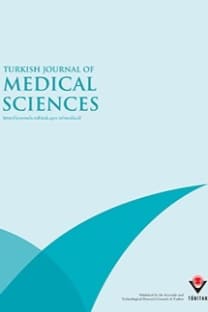Evaluation of outer hair cell function and medial olivocochlear efferent system in patients with type II diabetes mellitus
Key words: Diabetes mellitus, contralateral suppression, medial olivocochlear efferent, transient evoked otoacoustic emissions, distortion product otoacoustic emissions, hearing
Evaluation of outer hair cell function and medial olivocochlear efferent system in patients with type II diabetes mellitus
Key words: Diabetes mellitus, contralateral suppression, medial olivocochlear efferent, transient evoked otoacoustic emissions, distortion product otoacoustic emissions, hearing,
___
- Maison SF, Liberman MC. Predicting vulnerability to acoustic
- injury with a noninvasive assay of olivocochlear reflex strength.
- J Neurosci 2000; 20: 4701–4707. 9.
- Hall JW. Handbook of Otoacoustic Emissions. San Diego, CA,
- USA: Singular Thomson Learning, 2000.
- Yost WA. Fundamentals of Hearing. San Diego, CA, USA: Academic Press, 2000.
- Berlin CI, Hood LJ, Cecola RP, Jackson DF, Szabo P. Does type I afferent neuron dysfunction reveal itself through lack of efferent suppression? Hear Res 1993; 65: 40–50.
- Collet L. Use of otoacoustic emissions to explore the medial olivocochlear system in humans. Br J Audiol 1993; 27: 155–159.
- Harrell RW. Puretone evaluation. In: Katz J, editor. Handbook of Clinical Audiology. Philadelphia: Lippincott Williams Wilkins, 2002. pp. 71–87.
- Cullen JR, Cinnamond MJ. Hearing loss in diabetics. J Laryngol Otol 1993; 107: 179–182.
- Axelsson A, Sigroth K, Vertes D. Hearing in diabetics. Acta Otolaryngol Suppl 1978; 356: 1–23.
- Ottaviani F, Dozio N, Neglia CB, Riccio S, Scavini M. Absence of otoacoustic emissions in insulin-dependent diabetic patients: is there evidence for diabetic cochleopathy? J Diabetes Complications 2002; 16: 338–343.
- Karabulut H, Dagli M, Ates A, Karaaslan Y. Results for audiology and distortion product and transient evoked otoacoustic emissions in patients with systemic lupus erythematosus. J Laryngol Otol 2010; 124: 137–140.
- Korres SG, Balatsouras DG, Economou C, Ferekidis E, Kandiloros D, Adamopoulos G. Effect of the number of averaged responses in transient evoked otoacoustic emissions on the results of neonatal hearing screening. Audiology 2000; 39: 293–299.
- Namyslowski G, Morawski K, Kossowska I, Lisowska G, Koehler B, Jarosz-Chobot P. Contralateral suppression of TEOAE in diabetic children. Effects of 1.0 kHz and 2.0 kHz pure tone stimulation--preliminary study. Scand Audiol Suppl 2001; 126–129.
- Ugur AK, Kemaloglu YK, Ugur MB, Gunduz B, Saridogan C, Yesilkaya E, Bideci A, Cinaz P, Goksu N. Otoacoustic emissions and effects of contralateral white noise stimulation on transient evoked otoacoustic emissions in diabetic children. Int J Pediatr Otorhinolaryngol 2009; 73: 555–559.
- Hood LJ, Berlin CI, Bordelon J, Rose K. Patients with auditory neuropathy/dys-synchrony lack efferent suppression of transient evoked otoacoustic emissions. J Am Acad Audiol 2003; 14: 302–313.
- Göksoy C, Utkuçal R. Contralateral white noise-induced enhancement in the guinea pigs MLR: a possible link to directional hearing. Turk J Med Sci 2000; 30: 433–439.
- Maison S, Micheyl C, Collet L. Sinusoidal amplitude modulation alters contralateral noise suppression of evoked otoacoustic emissions in humans. Neuroscience 1999; 91: 133–138.
- Gkoritsa E, Korres S, Segas I, Xenelis I, Apostolopoulos N, Ferekidis E. Maturation of the auditory system: 2. Transient otoacoustic emission suppression as an index of the medial olivocochlear bundle maturation. Int J Audiol 2007; 46: 277– 286.
- Oliveira JR, Fernandes JC, Costa Filho OA. Age impact on the efferent system activities in cochlear mechanical properties in normal hearing individuals. Braz J Otorhinolaryngol 2009; 75: 340–344.
- Berlin CI, Hood LJ, Hurley AE, Wen H, Kemp DT. Binaural noise suppresses linear click-evoked otoacoustic emissions more than ipsilateral or contralateral noise. Hear Res 1995; 87: 96–103.
- Karabulut H, Hizli S, Dagli M, Karabulut I, Acar B, Celik E, Abaci A, Ozdemir O, Karasen RM. Audiological findings in celiac disease. ORL J Otorhinolaryngol Relat Spec 2011; 73: 82–87.
- Makishima K, Tanaka K. Pathological changes of the inner ear and central auditory pathway in diabetics. Ann Otol Rhinol Laryngol 1971; 80: 218–228.
- Bayazit Y, Yilmaz M, Kepekci Y, Mumbuc S, Kanlikama M. Use of the auditory brainstem response testing in the clinical evaluation of the patients with diabetes mellitus. J Neurol Sci 2000; 181: 29–32.
- ISSN: 1300-0144
- Yayın Aralığı: 6
- Yayıncı: TÜBİTAK
Prognostic value of neutrophil/lymphocyte ratio in patients with pulmonary embolism
Umut Yücel ÇAVUŞ, Sinan YILDIRIM, Ertan SÖNMEZ, Çağatay ERTAN, Özcan ÖZEKE
Liver enzymes, mean platelet volume, and red cell distribution width in gestational diabetes
Serpil ERDOĞAN, Özhan ÖZDEMİR, Halef Okan DOĞAN, Sevilay SEZER, Cemal Reşat ATALAY, Fatma Meriç YILMAZ, Yüksel KOCA
Choroidal thickness in healthy Turkish subjects
Erol COŞKUN, Seydi OKUMUŞ, Bülent GÜRLER, Ramazan YAYUSPAYI, Burak ÖREN, Erdal KAYDU, Ayşegül ÇÖMEZ, İbrahim ERBAĞCI
Epistaxis in geriatric patients
Alper YÜKSEL, Hanifi KURTARAN, Ekrem Said KANKILIÇ, Nebil ARK, Kadriye Şerife UĞUR, Mehmet GÜNDÜZ
Comparison of the effects of different percutaneous tracheotomy techniques on acute tracheal trauma
Cengiz Bekir DEMİREL, Hacer HALTAŞ, Hasan Kutluk PAMPAL, Yusuf ÜNAL, Berrin IŞIK, Mükerrem UYSAL
Sevilay SEZER, Fatma UÇAR, Ersin Kasım ULUSOY, Serpil ERDOĞAN, Şule BİLEN, Cevdet ZÜNGÜN, Sema UYSAL, Hacı Kemal ERDEMLİ
Is perioperative examination of frozen sections necessary in nephron-sparing surgery?
Mehmet KALKAN, Soner YALÇINKAYA, Coşkun ŞAHİN, Yeşim ÜÇKURT, Ömer ETLİK
The diagnostic value of ischemia-modified albumin in the diagnosis of aortic pathology
Oğuz EROĞLU, Süha TÜRKMEN, Ahmet MENTEŞE, Gökalp ALTUN, Süleyman TÜREDİ, Umut ERYİĞİT, Süleyman Caner KARAHAN, Abdülkadir GÜNDÜZ
Evaluation of malaria cases in individuals after traveling to endemic regions of the world
Hülya ÇAŞKURLU, Emine PAKIR, Aslıhan ÇOLAK
Ocular surface culture changes in patients after septoplasty
Mahmut ÖZKIRIŞ, Zeliha KAPUSUZ GENCER, Çiğdem KADER, Levent SAYDAM
